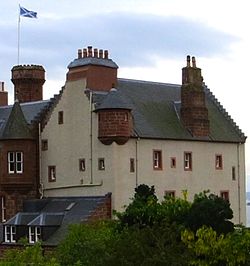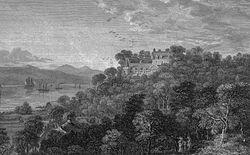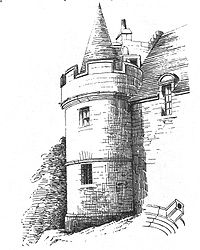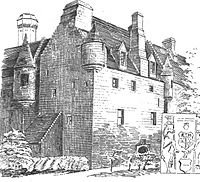Skelmorlie Castle
| Skelmorlie Castle | |
|
Ayrshire | |
|---|---|
 Skelmorlie Castle in 1829 | |
| Type: | Tower house |
| Location | |
| Grid reference: | NS19526584 |
| Location: | 55°51’7"N, 4°53’5"W |
| Town: | Skelmorlie |
| History | |
| Built end 15th/early 16th century | |
| Information | |
| Condition: | Maintained as a private residence |
| Owned by: | Private |
Skelmorlie Castle stands on the eastern shore of the Firth of Clyde, at the north-western corner of Ayrshire. The castle dates from 1502, and was formerly the seat and stronghold of the Montgomery family.[1] The modern village of Skelmorlie lies to the north of the castle.
History

The name is given as 'North Skelmoirluy' on Robert Gordon's map of 1636-52; 'Skelmurly' on John Adair's map of 1685; and 'Skelmorly' on William Roy's map of 1745-47. The origin of the name may be 'shelter leeside of the great rock' and 'Skel-' may be equivalent to 'Skeir' and 'Skerries.'[2]
The Cunninghame family
During the reign of King Robert III (1390–1406), the lands of Skelmorlie were held by the Cunninghames of Kilmaurs; in about 1460 the northern portion passed into the hands of the Montgomeries as Skelmorlie-Montgomerie, the remainder continuing as Skelmorlie-Cunninghame.[3] Anne, sister of Alexander de Montgomerie married a Cunninghame of Kilmaurs and this may explain the division of the lands.[4]
The Montgomerie family
On 6 June 1461 Sir Alexander de Montgomerie of Ardrossan, the first Lord Montgomerie, granted the lands of Skelmorlie to his second son by Margaret Boyd (daughter of Sir Thomas Boyd of Kilmarnock), George, thereby was the founder of the cadet branch, the Montgomeries of Skelmorlie.[3] George was also granted the lands of Lochliboside, Hartfield, and Colpy in the Barony of Renfrew.[5] Another view is that Skelmorlie Castle was built by a brother of Hugh, the first Earl of Eglinton, the grandson of the first Lord Montgomerie.[1]
The sixth laird, Robert, murdered Alexander Cunninghame, commendator of Kilwinning Abbey at his castle and palace of Montgreenan in 1586, following the murder, by the Cunninghames, of the fourth Earl of Eglinton.[4] The elder Sir Robert and his eldest son were in revenge killed by Patrick Maxwell of Newark Glasgow.[6]
Robert Montgomerie, seventh laird, was knighted by James VI and in 1628 created a baronet by Charles I. He was the son of another Robert; his mother was Dorothy, daughter of Lord Sempill. This Sir Robert married Margaret, daughter of Sir William Douglas of Drumlanrig.[3] Sir Robert ended the blood feud with the Maxwells.
Sir James, fourth baronet and tenth laird, was a member of the 1689 Parliament and Convention, and one of those chosen to administer the oath (the offer of the Crown) to King William and Queen Mary in London, though he later became a turncoat and died rejected by both sides.
Twentieth and twenty-first centuries
The 16th Earl of Eglinton moved here from the abandoned Eglinton Castle, hitherto the Montgomerie family seat in the mid-1920s, but it was sold by the 18th Earl of Eglinton, having been leased to the Wilson family since 1956. The 16th Earl died at Skelmorlie Castle in 1945.[7]
The castle became the property of the Wilson family in the mid-1970s, also the owners of the meat canning factory at Eglinton Castle, Kilwinning.[8] The castle was advertised for sale in 2007[9] and passed to new private owners in the summer of 2009.
The castle and grounds

The original Skelmorlie Castle may have stood on a motte which is situated in a defensive position on a promontory on ground lying between a small burn and the Skelmorlie Water (NS213660).[10]
The oldest portion of the present day castle was built in 1502 and added to in 1636, when corbelling and parapets were removed, whilst angle turrets, later roofed, were added.[3][10][11] Timothy Pont in his survey of Cunninghame around the year 1600 describes Skelmorlie Castle as "a fair well built house. The castle is certainly, in point of situation, a very pleasant and most delightful place, with its old-fashioned gardens, terrace and shrubbery. The view from it over the Firth of Clyde, to the opposite islands of Bute, Arran and Cumbraes, is not to be surpassed in picturesque scenery by any prospect in Britain".[12]
The baronial hall was on the first floor and as a more modern day dining room it had the Montgomerie coat of arms on the roof with the date 1762. The castle chapel, converted in the 19th century to stables and servants' quarters, still stands at the western side of the southern courtyard. Sir Robert's 17th range survives in part.[10]
Skelmorlie tower is very similar in dimensions and internal arrangements to those towers at Little Cumbrae, Fairlie, and Law.[13]
 |
 |
| Skelmorlie Castle pictured in the 1880s | |
The grounds in the early 19th century are described as "beautifully laid out, and covered with rich and luxuriant woods. The principal disadvantage of this fine old mansion, as a modern residence, is certainly the difficulty of ascent to it, from the steepness of the hill on which it stands; but otherwise an agreeable, nay, delightful summer retreat." In the 1855 OS survey a bowling green and a sundial are shown. The old baronial mill still exists in the name 'Milnburn' close to the Skelmorlie Water and Skelmorlie Mains is marked.
The silhouette of the keep has remained largely unchanged for over five centuries. This red sandstone rubble construction was rough-cast harled in the early 1960s following a fire in 1959, which burnt out the upper floors of the keep and of the west wing. The wing was demolished and the keep restored.
The Serpent Mound
Near to the castle at Meigle is a 100-foot-high artificial mound. A Dr Phenè discovered this structure, and excavations revealed a paved platform shaped like a segment of a circle, together with many bones and charcoal.[14] It gained its name from the enthusiastic assertion that the mound was the site of Sun and serpent worship.
The mound itself may well be entirely natural. The paved platform at the top however is a genuine artefact.[15]
Archaeology
The RCAHMS record that a stone axe, about inches long, was found in a field at Skelmorlie (NS 19 67) and is now preserved in the Hunterian Museum, Glasgow.
A 'Judge's Mound', a possible Moot hill existed at the top of the Shaw Glen.[16]
Outside links
| ("Wikimedia Commons" has material about Skelmorlie Castle) |
- The Murder of Alexander Cunninghame and Cunninghame of Clonherb by Sir Robert Montgomerie of Skelmorlie - YouTube
- Skelmorlie History. Accessed : 2010-01-04
- Skelmorlie. Duncan's Castles. Accessed : 2010-01-03
- The Skelmorlie Aisle and the history of the Montgomerie family - YouTube
References
- ↑ 1.0 1.1 Boyd, Page 9
- ↑ Johnston, Page 267
- ↑ 3.0 3.1 3.2 3.3 Millar, Page 134
- ↑ 4.0 4.1 Smart, Page 13
- ↑ Paterson, Page 534
- ↑ Dobie, Page 343
- ↑ Strawhorn, Page 202
- ↑ Eglinton Archive
- ↑ Guardian Newspaper Accessed : 2010-01-10
- ↑ 10.0 10.1 10.2 Campbell, Page 245
- ↑ {{canmore|40697/details/skelmorlie+castle/ RCAHMS. Accessed : 2009-12-30]
- ↑ Millar, Page 134
- ↑ McGibbon, Page 174
- ↑ Harvey, Page 95
- ↑ Smart, Page 6
- ↑ CANMORE (RCAHMS) record of Skelmorlie Mains: Judge Hill
- Boyd, John Rev: 'An 1879 Guide to Wemyss Bay, Skelmorlie, Inverkip, Largs and the surrounding districts with maps and illustrations' (Alexander Gardner, 1879)
- Eglinton Archive, Eglinton Country Park.
- Campbell, Thorbjorn: 'Ayrshire. A Historical Guide' (Birlinn, 2003) ISBN 1-84158-267-0
- Clan Montgomery Society of North America. 1983 Tour of Scotland.
- Dobie, James D. (ed Dobie, J.S.): 'Cunninghame, Topographized by Timothy Pont 1604–1608, with continuations and illustrative notices' (John Tweed, 1876)
- Fullarton, John: 'Historical Memoir of the family of Eglinton and Winton' (Arthur Guthrie, 1864)
- Harvey, William: 'Picturesque Ayrshire' (Valentine & Sons)
- Johnston, James B.: 'Place-Names of Scotland' (David Douglas, 1903)
- Leighton, John M.: 'Strath-Clutha or the Beauties of the Clyde' (Joseph Swan, Engraver)
- Love, Dane: 'Ayrshire : Discovering a County. Ayr (Fort Publishing, 2003) ISBN 0-9544461-1-9
- MacGibbon, T. and Ross, D.: 'The castellated and domestic architecture of Scotland from the twelfth to the eighteenth centuries' (1887–92)
- Macintosh, John: 'Ayrshire Nights' Entertainments' (Dunlop and Drennan, 1894)
- Millar, A. H.: 'The Castles & Mansions of Ayrshire' (Grimsay Press, 1885) ISBN 1-84530-019-X
- Muniments of the Royal Burgh of Irvine (Ayrshire & Galloway Archaeological Association, 1891)
- Paterson, James: 'History of the Counties of Ayr and Wigton' V. - II – Cunninghame (1863–66)
- Smart, Walter: 'Skelmorlie. The Story of the Parish Consisting of Skelmorlie and Wemyss Bay' (The Skelmorlie and Wemyss Bay Community Centre, 1968)
- Strawhorn, John: 'The History of Irvine' (John Donald, 1994) ISBN 0-85976-140-1
